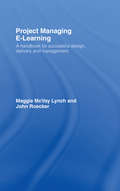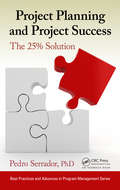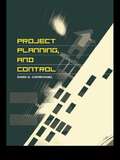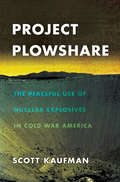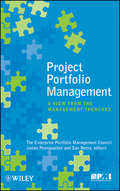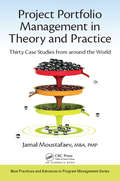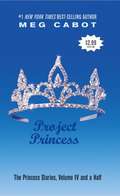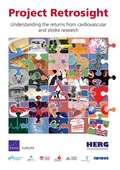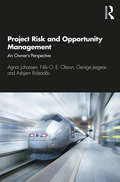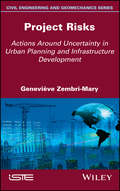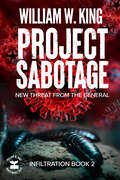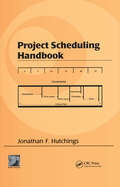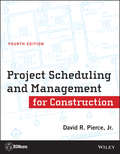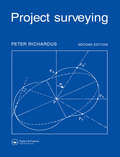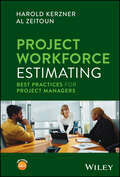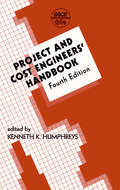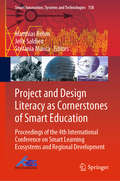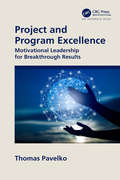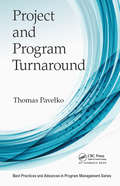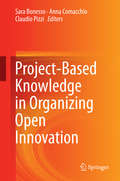- Table View
- List View
Project Management: Systems, Principles, and Applications, Second Edition (Systems Innovation Book Series)
by Adedeji B. BadiruThe goal of the new edition is to continue with a systems view of the world. For a more robust and worldwide market dissemination, the new edition has changed to a reference book. The project systems approach to project management, is needed in executing projects across countries and across cultures, which is a crucial requirement in today's globalized and intertwined economics. The book uses ample graphical representations to clarify the concepts and techniques presented. The case examples help to reinforce the topics covered. Several illustrative examples and practice exercises are included. Each chapter is updated and new chapters include Project Simulation and Project Templates. A new chapter on managing complex projects in an age of artificial intelligence adds a unique value to the book. Features Highlights contemporary best practices of project management Uses a systems framework to integrate quantitative and qualitative tools Offers illustrative examples and practice exercises Covers project schedule performance appraisal techniques Discusses the knowledge areas contained in the Project Management Book of Knowledge (PMBOK) Presents software applications for project management, as well as case examples
Project Managing E-Learning: A Handbook for Successful Design, Delivery and Management
by John Roecker Maggie McVay LynchProject Managing E-learning provides an essential framework, based on the globally accepted IPECC model, for planning, designing, delivering, managing and evaluating e-learning projects successfully. It focuses on practical, easy-to-understand methods and offers applications of project management principles in the real world. Illustrated by case studies of projects undertaken in business and academia it provides a step-by-step guide and highlights where projects typically fail. Each chapter begins with a definition and conceptualisation of the process, provides examples of how the process steps may vary dependent on organization or project size and discusses the typical problems organisations face when performing steps in the project management process. Covering all of the essentials as well as cutting-edge technology, it guides designers and managers through all stages of implementing and managing a project. Selected themes include: using focus groups gaining sponsors risk management pedagogical considerations testing quality control how to know when trouble is imminent PM software systems podcasting. The practical framework and sound advice offered in Project Managing E-learning is essential reading for all those who want to successfully implement and manage high quality e-learning in both academic and corporate training settings on time and to budget.
Project Mc2: Smart is the New Cool (Project Mc2)
by Jade Hemsworth Jordana ArkinMEET THE GIRLS OF PROJECT Mc2! <P>McKeyla McAlister: brilliant leader and savvy special agent for NOV8Adrienne Attoms: culinary chemist and sweet scientist Bryden Bandweth: technology guru and social media maven Camryn Coyle: construction queen and engineer extraordinaire ADORABLE PRINCE XANDER is coming to town for his launch into outer space--and the students of Maywood Glen Academy can't stop talking about it. No one even notices the mysterious new girl, McKeyla McAlister, who enrolls just before the big event.The smartest girls at school--Adri, Bry, and Cam--think McKeyla is definitely I.A.W.A.T.S.T.--Interesting And Weird At The Same Time. They discover she is an agent for NOV8 (that's Innovate), a top secret organization of super smart women, and her assignment is to keep the prince safe! <P>With the help of high tech gadgets, cool culinary chemistry, and some awesome teamwork, these girls may just save the world.
Project Mercury
by Ray Spangenburg Kit MoserDescribes the planning, development, missions, and accomplishments of Project Mercury and its contributions to the American presence in space.
Project Middle School (Alyssa Milano's Hope #1)
by Debbie Rigaud Alyssa MilanoFrom actor and lifelong activist Alyssa Milano comes Hope Roberts, a girl who's determined to change the world.Hope is eleven years old, and she wants to be an astrophysicist. She loves swimming, Galaxy Girl comic books, her best friend Sam, and her two rescue dogs.Hope believes it's always a good day to champion a cause, defend an underdog, and save the future. And most of all, she believes in dreaming big. That's why she's enrolled in all of the advanced classes at her new middle school. She's smart and confident in her abilities. But though Hope seems super strong on the outside, there's another side of her, too. She's just a regular girl trying to survive middle school.It's the beginning of sixth grade, and Hope's BFF quickly meets a new group of friends in her classes. Hope doesn't know how to handle it. She and Sam have always been inseparable! Things don't go as well for Hope. She embarrasses herself in front of her whole class, and then she gets off on the wrong foot with her new classmate, Camila. Even science club doesn't go as planned. None of the boys in the club will listen to the girls' ideas, and Hope and Camila get stuck doing the boring part of their science project, even though it was their idea. But Hope is determined to prove herself to the boys -- even if it means doing a lot of extra work on her own. She knows that sometimes changing the world starts small. So now Hope has a mission! Can she turn the science club into a place that's welcoming for everyone -- and make some new friends along the way?Hope's relatability, kindness, empathy, and can-do attitude will inspire a generation of do-gooders. This new series is a response to the very palpable feeling that not only can young people save the world -- they will!
Project Planning and Project Success: The 25% Solution (Best Practices In Portfolio, Program, And Project Management Ser. #15)
by Pedro SerradorProject planning is generally accepted as an important contributor to project success. However, is there research that affirms the positive impact of project planning and gives guidance on how much effort should be spent on planning? To answer these questions, this book looks at current literature and new research of this under-studied area of proj
Project Planning, and Control
by David G. CarmichaelProject management is widely used in the construction industry and is central to planning and controlling time, costs and resources. This book enables readers to perform more effectively, to understand project planning and control procedures and to gain an insight into the associated skills. Numerous case examples from diverse industries and exercises support and illustrate important concepts. The result is a new perspective for project managers: planning can be shown to be a systems synthesis or an inverse problem, which provides a way to reach a satisfactory solution, avoiding the time-consuming or impractical search for the optimal solution.
Project Plowshare: The Peaceful Use of Nuclear Explosives in Cold War America
by Scott KaufmanInspired by President Dwight D. Eisenhower's "Atoms for Peace" speech, scientists at the Atomic Energy Commission and the University of California's Radiation Laboratory began in 1957 a program they called Plowshare. Joined by like-minded government officials, scientists, and business leaders, champions of "peaceful nuclear explosions" maintained that they could create new elements and isotopes for general use, build storage facilities for water or fuel, mine ores, increase oil and natural gas production, generate heat for power production, and construct roads, harbors, and canals. By harnessing the power of the atom for nonmilitary purposes, Plowshare backers expected to protect American security, defend U.S. legitimacy and prestige, and ensure access to energy resources.Scott Kaufman's extensive research in nearly two dozen archives in three nations shows how science, politics, and environmentalism converged to shape the lasting conflict over the use of nuclear technology. Indeed, despite technological and strategic promise, Plowshare's early champions soon found themselves facing a vocal and powerful coalition of federal and state officials, scientists, industrialists, environmentalists, and average citizens. Skeptical politicians, domestic and international pressure to stop nuclear testing, and a lack of government funding severely restricted the program. By the mid-1970s, Plowshare was, in the words of one government official, "dead as a doornail." However, the thought of using the atom for peaceful purposes remains alive.
Project Portfolio Management
by Inc. EpmcWritten by ten successful project portfolio managers from companies including AAA, Boeing, Franklin Templeton, Johnson & Johnson, Safeway, and the UK Government, this easy-to-follow guide takes you through the project portfolio management process. It's based on what actually works, giving you a clear road map and the tools needed to determine the optimal mix and sequencing of projects in order to meet your organization's goals. The book begins by explaining basic PPM principles and why PPM is more critical than ever for business success. This introduction is followed by a story, tracking the experiences of a manager new to PPM as he discovers the issues that all of us face in trying to get traction with our PPM initiatives. In answering the questions our story raises, the book then details each step of the PPM process, using cases and examples drawn from the authors' first hand experience to help you address such key questions as: Which projects should our organization invest in?How can we optimize our organization's capacity?How well are we executing the PPM process?Can our organization absorb all the changes that our PPM plan requires?Are we achieving all the expected benefits?The authors are all members of the Enterprise Portfolio Management Council, a group of senior portfolio management executives dedicated to helping organizations develop their own portfolio management capabilities. Now you can benefit from their collective wisdom and experience, and duplicate their successful results within your own organization.
Project Portfolio Management in Theory and Practice: Thirty Case Studies from around the World (Best Practices in Portfolio, Program, and Project Management #24)
by Jamal MoustafaevEvery CEO in the world, if questioned, will always complain that there are a lot of ideas to implement, but, unfortunately, insufficient resources to accomplish them. This book provides a solution to this dilemma by supplying techniques to assess the value of projects, prioritize projects, and decide which projects to implement and which to postpone. In addition, it describes various methods of balancing project portfolios and different strategic alignment models. The book provides thirty real-life project portfolio management case studies from pharmaceutical, product development, financial, energy, telecommunications, not-for-profit and professional services industries.
Project Princess (The Princess Diaries Volume IV and a Half)
by Meg CabotFrom the back cover: "Hammer in hand, Princess Mia embarks on an epic adventure for one so admittedly unhandy: Along with her cohorts from school, she's off to build houses for the less fortunate. It doesn't take Mia long to realize that helping others -- while an unimpeachably noble pastime -- is very hard work. Will her giving spirit prevail? Will the house collapse due to royally clumsy construction? And most importantly, will Michael stop working long enough to kiss her?"
Project Quality Management
by Sui Pheng Low Joy OngThe book presents the development of the Construction Quality Assessment System (CONQUAS), Singapore's de facto quality performance measurement system, explains the application of the Quality Management System (QMS) to manage CONQUAS and identifies 33 critical success factors (CSFs) for achieving high CONQUAS scores. Through CONQUAS, the reader benefits from understanding how the Singapore government developed and implemented the first objective system for measuring what many building professionals have perceived to be elusive quality standards in the construction industry. The book presents both the theoretical concepts as well as the practical aspects to achieving strategic Project Quality Management that is anchored on the CSFs to building best practices. To realistically reflect the practical aspects and challenging issues faced by stakeholders in the construction industry, questionnaire surveys were conducted with building professionals to distinguish the importance level and extent of adoption of the 33 CSFs (identified from a comprehensive review of the extant literature) in influencing and affecting the achievement of high CONQUAS scores. These were further anchored by in-depth interviews with quality experts in the Singapore construction industry to provide a better understanding of issues relating to strategic Project Quality Management. Collectively, the empirical findings collated from the building professionals suggest that while the CSFs identified are known tenets of quality, these were still not being followed in their totality. A further case study was conducted through a formal set of in-depth interviews with the quality assurance team of a construction company who has direct involvement before, during and after their tremendous improvements in the CONQUAS scores attained. The strength of this book therefore represents a true account and reflections of real-life practices and experiences in the construction industry for contractors, quality managers and policy-makers to learn from. Although the context of this book relates to the Singapore experience, the lessons and recommendations are equally relevant and applicable to the global construction industry in both the developing and developed countries whose stakeholders (in both the public and private sectors) wish to understand how CONQUAS works, and how the CSFs identified can likewise be implemented for strategic Project Quality Management to building best practices. The book is therefore of interests to researchers, academia and practitioners in the construction industry as well as in other sectors of the economy (in Singapore and other countries) where learning points may be used for enhancing project quality management for buildings.
Project Retrosight
by Stephen Hanney Alexandra Pollitt Jonathan Grant Steven Wooding Martin BuxtonThis work explores impacts of cardiovascular and stroke research funded 15-20 years ago and draws out aspects associated with high or low impact. It describes 29 case studies of grants from Australia, Canada and UK. Policy summary volume.
Project Risk and Opportunity Management: The Owner's Perspective
by Asbjørn Rolstadås Agnar Johansen Nils O. Olsson George JergeasEffective risk and opportunity management is key to the successful delivery of any major engineering and construction project. This book looks at how all those involved can manage risk and capitalise on the opportunities that uncertainty present. The authors of this book highlight that uncertainties should be managed rather than avoided. This book will look at simple projects with a small team, to megaprojects where some hundreds of people are involved, and the consequences of delays or unforeseen costs. However, while the obvious risks can be planned for, the authors argue that it is often the opportunities in these situations that can have unexploited potential. This book is about opportunity management seen from the owner’s perspective. It will be an invaluable resource for those studying Engineering both undergraduate and postgraduate and set out ways in which projects should be managed from planning to completion. This book is also a great tool for those working in project management and the construction industry. While there are many books that demonstrate effective construction management, this book is the first of its kind to emphasise that there is opportunity in uncertainty, and possibility in the unexpected.
Project Risks: Actions Around Uncertainty in Urban Planning and Infrastructure Development
by Geneviève Zembri-MaryThose tasked with the planning and construction of infrastructure and development operations face an increasingly uncertain context in which they must address risks across a number of different fields. These range from the environmental and archaeological to the social, political and financial. As a consequence, the formal and informal practices of stakeholders often incorporate projections of risk and opportunity. Project Risks analyzes this paradigm shift. It reviews the origin and nature of these uncertainties, and the practices implemented by the actors to mitigate or take advantage of them. Paradoxically, these practices generate new risks and power relations that are not compatible with the collaborative planning model. These paradoxes force the rethinking of practices such as project territorialization, risk taking in planning and the responsibility of actors, as well as the societal and political choices that must be made between the realization of projects and the protection of the environment.
Project Sabotage: New Threat from the General (Infiltration)
by William King William W. KingThe author of Project Inferno brings back the United States&’ greatest threat in the second novel in the thrilling Infiltration series. The shadowy figure known only as &“The General&” is a master of technological espionage. In Project Inferno, the first book in the Infiltration series, The General launched an insidious campaign to start fires in American homes. His plot was exposed and catastrophe was narrowly averted. The General is back with a new scheme, one far more dangerous and far more insidious. With Americans quarantined at home during the pandemic, the new threat is even more dangerous. And this time his target is Silicon Valley.
Project Scheduling Handbook (Civil And Environmental Engineering Ser. #Vol. 15)
by Jonathan F. HutchingsOffering real-world strategies gleaned from years of professional experience, this book contains the essential tools to prepare a well-organized, efficient, and effective working production schedule for successful construction outcomes. The only guide to address the day-to-day needs with hands-on, problem-resolution strategies, the book views the i
Project Scheduling and Management for Construction (RSMeans #89)
by David R. Pierce Jr.First published in 1988 by RS Means, the new edition of Project Scheduling and Management for Construction has been substantially revised for students enrolled in construction management and civil engineering programs. While retaining its emphasis on developing practical, professional-level scheduling skills, the new edition is a relatable, real-world case study that can be used over the course of a semester. The book also includes classroom elements like exercises, quizzes, skill-building exercises, as well as an instructor's manual including two additional new cases.
Project Surveying: Completely revised 2nd edition - General adjustment and optimization techniques with applications to engineering surveying
by RichardusA text for the student & the professional.
Project Workforce Estimating: Best Practices for Project Managers
by Harold Kerzner Al ZeitounPlace the right people in the right roles at the right time with this essential guide Project estimating, or project workforce planning, involves a systematic process of identifying and managing the key human resources required for efficient and effective completion of a project. This process necessarily balances a huge range of factors, from forecasting labor costs to managing team composition to incorporating relevant legislation and projecting the impact of artificial intelligence and market conditions. Effective workforce planning contributes to overall project success by ensuring that the right people are in the right roles at the right time. Project Workforce Estimating: Best Practices for Project Managers offers a comprehensive overview of workforce planning, from foundational principles to advanced techniques. It offers a range of techniques and strategies that can be incorporated into planning for virtually any kind of project, along with detailed guidance to ensure accurate projections. Closely aligned with industry standards, it is a must-own for project managers looking to systematize a critical stage of project management. Project Workforce Estimating: Best Practices for Project Managers readers will also find: Information aligned with standards such as the PMBOK® Guide and Earned Value Management SystemsA detailed exploration of global workforce estimation, project life cycle costing, and moreA range of techniques and strategies suitable for any possible industry Project Workforce Estimating: Best Practices for Project Managers is ideal for project managers, business analysts and consultants, executives and senior managers, and HR professionals.
Project and Cost Engineers' Handbook (Cost Engineering)
by Kenneth K. HumphreysMaking the specifics of a complex concern accessible and its handling quite manageable, this fourth edition of the Project and Cost Engineers' Handbook examines the variables associated with international projects and project risk analysis. It provides instruction on contingency planning, delves into ethical considerations, considers the imp
Project and Design Literacy as Cornerstones of Smart Education: Proceedings of the 4th International Conference on Smart Learning Ecosystems and Regional Development (Smart Innovation, Systems and Technologies #158)
by Matthias Rehm Jelle Saldien Stefania MancaThe book includes high-quality papers presented at the 4th International Conference on Smart Learning Ecosystems and Regional Development at Università Roma Tor Vergata, Italy, from 22 to 24 May, 2019. Providing insights into the relevance of smart learning ecosystems (schools, campuses, the workplace, informal learning contexts, etc.) for regional development and social innovation, it also discusses how citizens’ involvement with smart ecosystems can be increased and made more effective.
Project and Program Excellence: Motivational Leadership for Breakthrough Results
by Thomas PavelkoThis book provides insight, measures, and tools to manage a program or project to be first place amongst its competitors and similar efforts. Providing breakthrough insight by showing how to understand and use team member motivation, it gives leadership and team members the tools to be first place. It shows program and project managers how to motivate a team to perform better than its competitors while bringing great satisfaction and tailored growth to the team individuals. Highlights include: Selecting excellent task leads and determining the best team mix Fulfilling motivation needs during program and project execution Motivating high-tempo performance The very best performance of a program or project team occurs when the needs driving the fundamental motivations of team members are being met. This book explains how human motivation analysis substantiates the successful program and project, organizational and process elements that have been applied. By using the measure of providing promised deliverables within cost and schedule constraints and with managed risk, it describes team performance and explains the difference between a high-performance team and an average-performance one. It applies recent research of how motivation applies to programs and projects and how to accordingly organize a team. Beginning with an introduction of improvement concepts, this book reviews current program and project success statistics and then delves into how to reap the tremendous advantages of modern motivation-based organization leadership. It shows how to determine team member motivation and use it to assemble and execute a first-place program or project. Guidance includes showing how to assign the best mix of motivational types for each team and choosing leadership. Project and Program Excellence: Motivational Leadership for Breakthrough Results offers an organizational and leadership approach for highly successful development efforts.
Project and Program Turnaround (Best Practices in Portfolio, Program, and Project Management)
by Thomas PavelkoThe U.S. economy thrives on the development of new products, new systems, and new processes. Usually, these advances start as a flash of inspiration by highly creative individuals. It is complex and difficult to go from initial inspiration to a final product, process, or system. So it is not surprising that approximately one out of every four development programs fails. A development program or project in trouble is distinct from a program encountering typical development difficulties. Such a program or project can appear to be in free fall. This book identifies the essential fundamentals for executing a program or project turnaround effectively. These fundamentals include: Clearly identifying the next critical accomplishment needed for success Assigning responsibility for each program task to one person Capitalizing on colocation and face-to-face communication Recruiting problem solvers Wining commitment from team members Using team accomplishments to propel high team morale The guidance provided in this book is applicable to all program or project genres, including manufacturing, nonprofit work, education, medicine, investment management, and municipal management. Software has become a great part of both providing product functionality and assisting with managing product development. A special chapter devoted to software development dispels common misconceptions and provides guidance for turning around this special type of project or program. This book is a highly valuable source of insight for a wide range of readers, including management professionals, business students, and executive managers. Every member of a product or project development team will find its recommendations to be of high value.
Project-Based Knowledge in Organizing Open Innovation
by Sara Bonesso Anna Comacchio Claudio PizziEnriching understanding of the current theoretical debate on project-based learning and R&D sourcing, 'Project-based Knowledge in Organizing Open Innovation' draws on innovation literature and knowledge-based perspectives to solve open problems in the relationship between knowledge development at project level and how firms organize product innovation combining in-house R&D activities with inbound open innovation. Through field research in different industrial settings (pharmaceutical, automotive and machine tools) and with complementary methodological approaches, this book provides empirical evidence on how project knowledge features affect sourcing decisions at firm level. Due to the emerging interest in the management literature on project-based organizations and on the relevance of project forms of organizing in a knowledge-based economy, this volume will appeal to scholars and students in business and management, in particular those in innovation management, organization theory and strategic management. Addressing the still open issue of how the firm level should be complemented by studies at the project level of analysis, this book provides theoretical and empirical arguments on the advantages of a more fine-grained level of analysis to understand how firms organize their innovation processes across boundaries.

